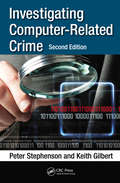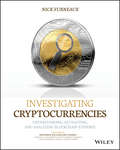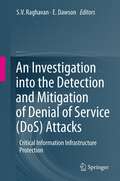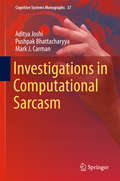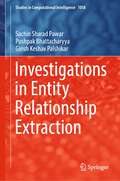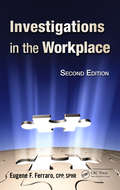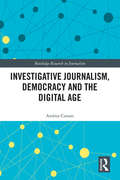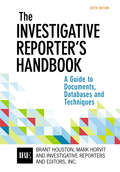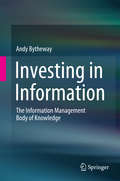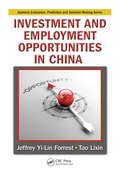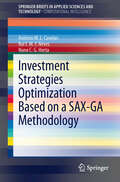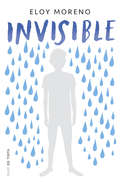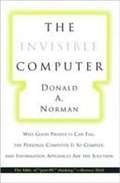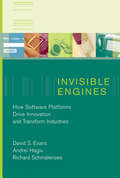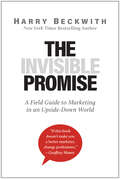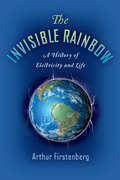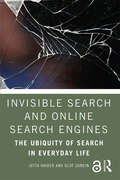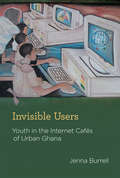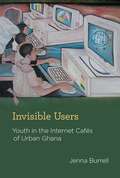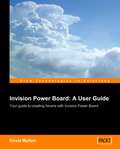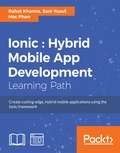- Table View
- List View
Investigating Computer-Related Crime
by Peter Stephenson Keith GilbertSince the last edition of this book was written more than a decade ago, cybercrime has evolved. Motives have not changed, but new means and opportunities have arisen with the advancement of the digital age. Investigating Computer-Related Crime: Second Edition incorporates the results of research and practice in a variety of venues, growth in the fi
Investigating Cryptocurrencies: Understanding, Extracting, and Analyzing Blockchain Evidence
by Nick Furneaux<p>Bitcoin has traditionally been the payment system of choice for a criminal trading on the Dark Web, and now many other blockchain cryptocurrencies are entering the mainstream as traders are accepting them from low-end investors putting their money into the market. Worse still, the blockchain can even be used to hide information and covert messaging, unknown to most investigators. <p><i>Investigating Cryptocurrencies</i> is the first book to help corporate, law enforcement, and other investigators understand the technical concepts and the techniques for investigating crimes utilizing the blockchain and related digital currencies such as Bitcoin and Ethereum. <p> <li>Understand blockchain and transaction technologies <li>Set up and run cryptocurrency accounts <li>Build information about specific addresses <li>Access raw data on blockchain ledgers Identify users of cryptocurrencies <li>Extracting cryptocurrency data from live and imaged computers <li>Following the money</li> <p> <p>With nearly $150 billion in cryptocurrency circulating and $3 billion changing hands daily, crimes committed with or paid for with digital cash are a serious business. Luckily, Investigating Cryptocurrencies Forensics shows you how to detect it and, more importantly, stop it in its tracks.</p>
Investigating Radicalization Trends: Case Studies in Europe and Asia (Security Informatics and Law Enforcement)
by Babak Akhgar Douglas Wells José María BlancoThis book provides a detailed insight into the complex dynamics of radicalization that are in play amongst contemporary society. The authors focus on understanding emerging trends and models that can be used to analyse and understand modern violent extremist and xenophobic discourse. The chapters cover multiple regions, providing a collective analysis of country-specific case studies for the formulation of best practices, recommendations and learning material. It is recommended that this book may serve as a compendium for practitioners, academics, teachers and students wishing to gain state-of-the art knowledge. Topics covered by the authors vary from hands-on practical information to tactical, operational, strategic and ethical guidance. This book provides a holistic, harmonized approach based upon European internal security strategies recognizing that internal security cannot be achieved in isolation from the rest of the world. Additionally, this material resonates with the EU’s commitment to fight extremism in a rational manner, alongside promoting human rights, democracy, peace and stability within the EU Member States.Presents a comprehensive understanding of the interconnectivities and trends behind emerging radicalisation patterns;Features newest conceptual and practical knowledge to monitor, analyse and respond to radicalization around the world;Provides a comprehensive view into the methodologies for analysis, through visualizations, case studies and applications.
An Investigation into the Detection and Mitigation of Denial of Service (DoS) Attacks: Critical Information Infrastructure Protection
by E Dawson S. V. RaghavanAround the globe, nations face the problem of protecting their Critical Information Infrastructure, normally referred to as Cyber Space. In this monograph, we capture FIVE different aspects of the problem; High speed packet capture, Protection through authentication, Technology Transition, Test Bed Simulation, and Policy and Legal Environment. The monograph is the outcome of over three years of cooperation between India and Australia.
Investigations in Computational Sarcasm (Cognitive Systems Monographs #37)
by Aditya Joshi Pushpak Bhattacharyya Mark J. CarmanThis book describes the authors’ investigations of computational sarcasm based on the notion of incongruity. In addition, it provides a holistic view of past work in computational sarcasm and the challenges and opportunities that lie ahead. Sarcastic text is a peculiar form of sentiment expression and computational sarcasm refers to computational techniques that process sarcastic text. To first understand the phenomenon of sarcasm, three studies are conducted: (a) how is sarcasm annotation impacted when done by non-native annotators? (b) How is sarcasm annotation impacted when the task is to distinguish between sarcasm and irony? And (c) can targets of sarcasm be identified by humans and computers. Following these studies, the book proposes approaches for two research problems: sarcasm detection and sarcasm generation. To detect sarcasm, incongruity is captured in two ways: ‘intra-textual incongruity’ where the authors look at incongruity within the text to be classified (i.e., target text) and ‘context incongruity’ where the authors incorporate information outside the target text. These approaches use machine-learning techniques such as classifiers, topic models, sequence labelling, and word embeddings. These approaches operate at multiple levels: (a) sentiment incongruity (based on sentiment mixtures), (b) semantic incongruity (based on word embedding distance), (c) language model incongruity (based on unexpected language model), (d) author’s historical context (based on past text by the author), and (e) conversational context (based on cues from the conversation). In the second part of the book, the authors present the first known technique for sarcasm generation, which uses a template-based approach to generate a sarcastic response to user input. This book will prove to be a valuable resource for researchers working on sentiment analysis, especially as applied to automation in social media.
Investigations in Entity Relationship Extraction (Studies in Computational Intelligence #1058)
by Sachin Sharad Pawar Pushpak Bhattacharyya Girish Keshav PalshikarThe book covers several entity and relation extraction techniques starting from the traditional feature-based techniques to the recent techniques using deep neural models. Two important focus areas of the book are – i) joint extraction techniques where the tasks of entity and relation extraction are jointly solved, and ii) extraction of complex relations where relation types can be N-ary and cross-sentence. The first part of the book introduces the entity and relation extraction tasks and explains the motivation in detail. It covers all the background machine learning concepts necessary to understand the entity and relation extraction techniques explained later. The second part of the book provides a detailed survey of the traditional entity and relation extraction problems covering several techniques proposed in the last two decades. The third part of the book focuses on joint extraction techniques which attempt to address both the tasks of entity and relation extraction jointly. Several joint extraction techniques are surveyed and summarized in the book. It also covers two joint extraction techniques in detail which are based on the authors’ work. The fourth and the last part of the book focus on complex relation extraction, where the relation types may be N-ary (having more than two entity arguments) and cross-sentence (entity arguments may span multiple sentences). The book highlights several challenges and some recent techniques developed for the extraction of such complex relations including the authors’ technique. The book also covers a few domain-specific applications where the techniques for joint extraction as well as complex relation extraction are applied.
Investigations in the Workplace
by Eugene F. Ferraro T.J. MacGinley Ban Seng ChooThe process of investigation is dynamic and fluid. The approach must be reasonable and the investigator flexible. However, in order to be successful, every investigation must have a meaningful purpose and be executed ethically and lawfully.Inevitably, employers must invest time, money, and patience to ensure they obtain demonstrable and actionable
Investigative Journalism, Democracy and the Digital Age (Routledge Research in Journalism)
by Andrea CarsonTheoretically grounded and using quantitative data spanning more than 50 years together with qualitative research, this book examines investigative journalism’s role in liberal democracies in the past and in the digital age. In its ideal form, investigative reporting provides a check on power in society and therefore can strengthen democratic accountability. The capacity is important to address now because the political and economic environment for journalism has changed substantially in recent decades. In particular, the commercialization of the Internet has disrupted the business model of traditional media outlets and the ways news content is gathered and disseminated. Despite these disruptions, this book’s central aim is to demonstrate using empirical research that investigative journalism is not in fact in decline in developed economies, as is often feared.
The Investigative Reporter’s Handbook: A Guide To Documents, Databases, And Techniques
by Brant Houston Mark Horvit Investigative Reporters Inc. EditorsBuild the fundamental investigative writing and reporting skills you need to investigate anything and anyone. The text’s easy-to-use handbook style allows readers to quickly access any information--everything from how to build quality reporting skills and collaborate on investigations to tips for researching a variety of beats. This is the text on investigative reporting, infused with illustrative quotes and instructive examples from highly-respected journalists around the world.
Investing in Information
by Andy BythewayThis book gathers together, in a new way, established and contemporary thinking about how to get the best out of information technology and information systems investments. Working managers who are beset by the complexities of information management in the age of Big Data and the Social Web, and students who are trying to make sense of information management in a chaotic world that is more and more driven by the Internet, will all benefit from this new treatment of a long-standing and problematic domain. Importantly, the book reveals and clarifies the dependencies that exist between the inner world of information technology and the outer world of people and organisations at work. The book differs from other books in its reflective approach. It avoids lengthy, descriptive, and prescriptive dogma. Rather, it provides tools for thinking about information management and it identifies strategic and tactical options at six levels: from the simple consideration of information technology and information systems, right through to issues of organisational performance and business strategy. At the heart of the matter are two critical and tightly connected issues: the ways that we conceive and manage an organisation's processes, and the ways that we conceive and manage the information that an organisation needs to sustain those processes. The six-level framework that achieves this clarity is the "Information Management Body of Knowledge" (familiarly known as the "IMBOK"). This easy-to-understand and easy-to-remember framework has been found to be extremely useful in business, in government, in civil society and in education. Throughout the book, selected research papers are identified and summarised. There are also summary chapters from three different operational perspectives: performance and competency assessment using the IMBOK, undertaking research into related issues, and a review of parallel expert thinking. This book stands as a reference point and resource for all those who need to straddle the disparate worlds of "information technology" and "business". It provides firm pedagogical foundations for courses dealing with business management in the information age, and it provides a sound reference framework for researchers who need to position research projects related to information technology and information systems in a wider context. For busy managers, who simply wish to identify, understand and successfully manage information technology-related opportunities, it provides an ideal arrangement of ideas and tools that will help them.
Investment and Employment Opportunities in China (Systems Evaluation, Prediction, and Decision-Making #9)
by Jeffrey Yi-Lin Forrest Tao LixinPresenting the most recent statistical data, Investment and Employment Opportunities in China provides first-of-its-kind coverage of the regional economic, industrial, investment, and employment structures in China. After establishing the theoretical foundation, the rest of the book utilizes the model and the methodology presented by the authors to
Investment Strategies Optimization based on a SAX-GA Methodology
by Rui F.M.F. Neves António M.L. Canelas Nuno C.G. HortaThis book presents a new computational finance approach combining a Symbolic Aggregate approximation (SAX) technique with an optimization kernel based on genetic algorithms (GA). While the SAX representation is used to describe the financial time series, the evolutionary optimization kernel is used in order to identify the most relevant patterns and generate investment rules. The proposed approach considers several different chromosomes structures in order to achieve better results on the trading platform The methodology presented in this book has great potential on investment markets.
Invisible
by Eloy MorenoEmotiva, conmovedora, diferente... Invisible narra, a través de los ojos de un niño, una historia que podría ser la de cualquiera de nosotros. ¿Quién no ha deseado alguna vez ser invisible? ¿Quién no ha deseado alguna vez dejar de serlo? El problema es que nunca he llegado a controlar bien ese poder: A veces, cuando más ganas tenía de ser invisible, era cuando más gente me veía, y en cambio, cuando deseaba que todos me vieran, era cuando a mi cuerpo le daba por desaparecer.
The Invisible Computer: Why Good Products Can Fail, the Personal Computer Is So Complex, and Information Appliances Are the Solution
by Donald A. NormanTechnologies have a life cycle, says Donald A. Norman, and they must change as they pass from youth to maturity. Alas, the computer industry thinks it is still in its rebellious teenage years, exalting in technical complexity.
Invisible Engines: How Software Platforms Drive Innovation and Transform Industries (The\mit Press Ser.)
by David S. Evans Andrei Hagiu Richard SchmalenseeHarnessing the power of software platforms: what executives and entrepreneurs must know about how to use this technology to transform industries and how to develop the strategies that will create value and drive profits.Software platforms are the invisible engines that have created, touched, or transformed nearly every major industry for the past quarter century. They power everything from mobile phones and automobile navigation systems to search engines and web portals. They have been the source of enormous value to consumers and helped some entrepreneurs build great fortunes. And they are likely to drive change that will dwarf the business and technology revolution we have seen to this point. Invisible Engines examines the business dynamics and strategies used by firms that recognize the transformative power unleashed by this new revolution—a revolution that will change both new and old industries.The authors argue that in order to understand the successes of software platforms, we must first understand their role as a technological meeting ground where application developers and end users converge. Apple, Microsoft, and Google, for example, charge developers little or nothing for using their platforms and make most of their money from end users; Sony PlayStation and other game consoles, by contrast, subsidize users and make more money from developers, who pay royalties for access to the code they need to write games. More applications attract more users, and more users attract more applications. And more applications and more users lead to more profits.Invisible Engines explores this story through the lens of the companies that have mastered this platform-balancing act. It offers detailed studies of the personal computer, video game console, personal digital assistant, smart mobile phone, and digital media software platform industries, focusing on the business decisions made by industry players to drive profits and stay a step ahead of the competition. Shorter discussions of Internet-based software platforms provide an important glimpse into a future in which the way we buy, pay, watch, listen, learn, and communicate will change forever. An electronic version of this book is available under a Creative Commons license.
The Invisible Promise: A Field Guide to Marketing in an Upside-Down World
by Harry BeckwithOur service economy is dominated by outmoded marketing models from the world of products. The Invisible Promise reveals the critical differences between service and product marketing and outlines a service-centric strategy for planning your business, persuading your prospects, and relating to your clients.Unlike products, you can&’t see, touch, or feel services. Marketing services requires an approach that doesn&’t rely on the traditional 4 Ps of product marketing: product, price, place, and promotion. Selling invisible services requires making the promise of their yet-unseen value resonate with prospective clients.In The Invisible Promise, Harry Beckwith, New York Times bestselling author of Selling the Invisible, applies his 40-plus years of advising businesses around the world and his research in the last 10 years to impart the proven guidance that businesses of all sizes desperately need. In this new age in marketing, he details how to build messages that enhance your reputation for integrity, stand out from the clutter, and can produce exponential growth while saving you both time and money.If you are responsible for marketing a service, the tried-and-true strategies for product marketing simply will not fit. You need to alter your approach radically.That&’s where The Invisible Promise comes in.
The Invisible Rainbow: A History of Electricity and Life
by Arthur FirstenbergElectricity has shaped the modern world. But how has it affected our health and environment? Over the last 220 years, society has evolved a universal belief that electricity is ‘safe’ for humanity and the planet. Scientist and journalist Arthur Firstenberg disrupts this conviction by telling the story of electricity in a way it has never been told before—from an environmental point of view—by detailing the effects that this fundamental societal building block has had on our health and our planet. In The Invisible Rainbow, Firstenberg traces the history of electricity from the early eighteenth century to the present, making a compelling case that many environmental problems, as well as the major diseases of industrialized civilization—heart disease, diabetes, and cancer—are related to electrical pollution.
Invisible Search and Online Search Engines: The Ubiquity of Search in Everyday Life
by Jutta Haider Olof SundinInvisible Search and Online Search Engines considers the use of search engines in contemporary everyday life and the challenges this poses for media and information literacy. Looking for mediated information is mostly done online and arbitrated by the various tools and devices that people carry with them on a daily basis. Because of this, search engines have a significant impact on the structure of our lives, and personal and public memories. Haider and Sundin consider what this means for society, whilst also uniting research on information retrieval with research on how people actually look for and encounter information. Search engines are now one of society’s key infrastructures for knowing and becoming informed. While their use is dispersed across myriads of social practices, where they have acquired close to naturalised positions, they are commercially and technically centralised. Arguing that search, searching, and search engines have become so widely used that we have stopped noticing them, Haider and Sundin consider what it means to be so reliant on this all-encompassing and increasingly invisible information infrastructure. Invisible Search and Online Search Engines is the first book to approach search and search engines from a perspective that combines insights from the technical expertise of information science research with a social science and humanities approach. As such, the book should be essential reading for academics, researchers, and students working on and studying information science, library and information science (LIS), media studies, journalism, digital cultures, and educational sciences.
Invisible Users: Youth in the Internet Cafés of Urban Ghana (Acting with Technology)
by Jenna BurrellAn account of how young people in Ghana's capital city adopt and adapt digital technology in the margins of the global economy.The urban youth frequenting the Internet cafés of Accra, Ghana, who are decidedly not members of their country's elite, use the Internet largely as a way to orchestrate encounters across distance and amass foreign ties—activities once limited to the wealthy, university-educated classes. The Internet, accessed on second-hand computers (castoffs from the United States and Europe), has become for these youths a means of enacting a more cosmopolitan self. In Invisible Users, Jenna Burrell offers a richly observed account of how these Internet enthusiasts have adopted, and adapted to their own priorities, a technological system that was not designed with them in mind.Burrell describes the material space of the urban Internet café and the virtual space of push and pull between young Ghanaians and the foreigners they encounter online; the region's famous 419 scam strategies and the rumors of “big gains” that fuel them; the influential role of churches and theories about how the supernatural operates through the network; and development rhetoric about digital technologies and the future viability of African Internet cafés in the region.Burrell, integrating concepts from science and technology studies and African studies with empirical findings from her own field work in Ghana, captures the interpretive flexibility of technology by users in the margins but also highlights how their invisibility puts limits on their full inclusion into a global network society.
Invisible Users
by Jenna BurrellThe urban youth frequenting the Internet cafes of Accra, Ghana, who are decidedly not members of their country's elite, use the Internet largely as a way to orchestrate encounters across distance and amass foreign ties--activities once limited to the wealthy, university-educated classes. The Internet, accessed on second-hand computers (castoffs from the United States and Europe), has become for these youths a means of enacting a more cosmopolitan self. In Invisible Users, Jenna Burrell offers a richly observed account of how these Internet enthusiasts have adopted, and adapted to their own priorities, a technological system that was not designed with them in mind. Burrell describes the material space of the urban Internet cafe and the virtual space of push and pull between young Ghanaians and the foreigners they encounter online; the region's famous 419 scam strategies and the rumors of "big gains" that fuel them; the influential role of churches and theories about how the supernatural operates through the network; and development rhetoric about digital technologies and the future viability of African Internet cafes in the region. Burrell, integrating concepts from science and technology studies and African studies with empirical findings from her own field work in Ghana, captures the interpretive flexibility of technology by users in the margins but also highlights how their invisibility puts limits on their full inclusion into a global network society.
Invision Power Board 2: A User Guide
by David MyttonThis book is a fast-paced guide to the most important features of Invision Power Board, and how to make best use of these features to power your forum. This book is written for new and intermediate users of Invision Power Board, who want to manage and maintain an Invision Power Board discussion forum as easily as possible. No experience of web programming is required.
Invitations to Tender for Facility Management Services: A Practical Guide For Effective Writing And Critical Analysis (Springer Tracts in Civil Engineering)
by Cinzia Talamo Nazly AttaThis book deals with Invitations to Tender (ITTs) for the provision of Facility Management (FM) services. It presents a framework to support companies in preparing clear, comprehensive and effective ITTs, focusing on such key aspects as: organizational structures, tools and procedures for managing information, allocation of information responsibilities, procedures for services monitoring and control, quality policies, and risk management. It discusses and analyzes a range of basic terms and concepts, procedures, and international standards concerning the Tendering Process, as well as the contents of ITTs, which should represent the translation of information needs into requirements related to: the client’s goals, main categories of information to deal with, expected organization of information, modalities of reporting and control, and level of knowledge to be reached. A further major focus is on potential key innovation scenarios concerning current FM practice, such as Sustainable Procurement, Building Information Modeling (BIM), Big Data and Internet of Things (IoT) technologies, highlighting both the possible benefits and the possible risks and implications that could negatively affect the quality of FM service provision if not properly treated within the ITT. The book will be of interest to real estate owners, demand organizations and facility managers, enhancing their ability to prepare, interpret and/or critically analyze ITTs.
Ion Beam Induced Defects and Their Effects in Oxide Materials (SpringerBriefs in Physics)
by Vinod Kumar Parmod Kumar Jitendra Pal Singh K. AsokanThis book provides an overview of the applications of ion beam techniques in oxide materials. Oxide materials exhibit defect-induced physical properties relevant to applications in sensing, optoelectronics and spintronics. Defects in these oxide materials also lead to magnetism in non-magnetic materials or to a change of magnetic ordering in magnetic materials. Thus, an understanding of defects is of immense importance. To date, ion beam tools are considered the most effective techniques for producing controlled defects in these oxides. This book will detail the ion beam tools utilized for creating defects in oxides.
Ionic: Hybrid Mobile App Development
by Hoc Phan Rahat Khanna Sani YusufAn end–to-end journey, empowering you to build real-time, scalable, and interactive mobile applications with the Ionic framework About This Book • Develop engaging mobile experiences with a native-looking UI in Ionic and AngularJS. • Use out-of-the-box Ionic functionalities, customize existing components, and add new components with this comprehensive course. • Learn Ionic by creating three complete mobile applications Who This Book Is For If you are a web developer who wants to build hybrid mobile app development using the Ionic framework, then this comprehensive course is best-suited for you. What You Will Learn • Get to know about Hybrid Apps and AngularJS • Set up a development environment to build Hybrid Apps • Navigate around components and routing in Ionic • Authenticate users using an e-mail password, Twitter, Facebook, Google+, and LinkedIn • Retrieve data and store it using Firebase • Access native device functionalities such as the camera, contact list, e-mail, and maps using NG-Cordova • Integrate PhoneGap plugins with NG-Cordova • Test your apps to improve and optimize performance In Detail Hybrid Apps are a promising choice in mobile app development to achieve cost-effectiveness and rapid development. Ionic has evolved as the most popular choice for Hybrid Mobile App development as it tends to match the native experience and provides robust components/tools to build apps. The Ionic Complete Developers course takes you on an end–to-end journey, empowering you to build real-time, scalable, and interactive mobile applications with the Ionic framework. Starting with an introduction to the Ionic framework to get you up and running, you will gradually move on to setting up the environment, and work through the multiple options and features available in Ionic to build amazing hybrid mobile apps. You will learn how to use Cordova plugins to include native functionality in your hybrid apps. You will work through three complete projects and build a basic to-do list app, a London tourist app, and a complete social media app. All three projects have been designed to help you learn Ionic at its very best. From setting up your project to developing on both the server side and front end, and best practices for testing and debugging your projects, you'll quickly be able to deliver high-performance mobile apps that look awesome. You will then hone your skills with recipes for cross-platform development. Integrating Ionic with Cordova will bring you native device features, and you will learn about the best modules from its ecosystem. Creating components and customizing the theme will allow you to extend Ionic. You'll see how to build your app to deploy to all platforms to make you a confident start-to-finish mobile developer. This Learning Path combines some of the best that Packt has to offer in one complete, curated package. It includes content from the following Packt products: • Getting Started with Ionic – by Rahat Khanna • Ionic by Example – by Sani Yusuf • Ionic Cookbook – by Hoc Phan Style and approach This course shows you how to get up and running with the Ionic framework. It doesn't just give you instructions, expecting you to follow them. Instead, with a hands-on approach, it demonstrates what Ionic is capable of through a series of practical projects that you can build yourself.
